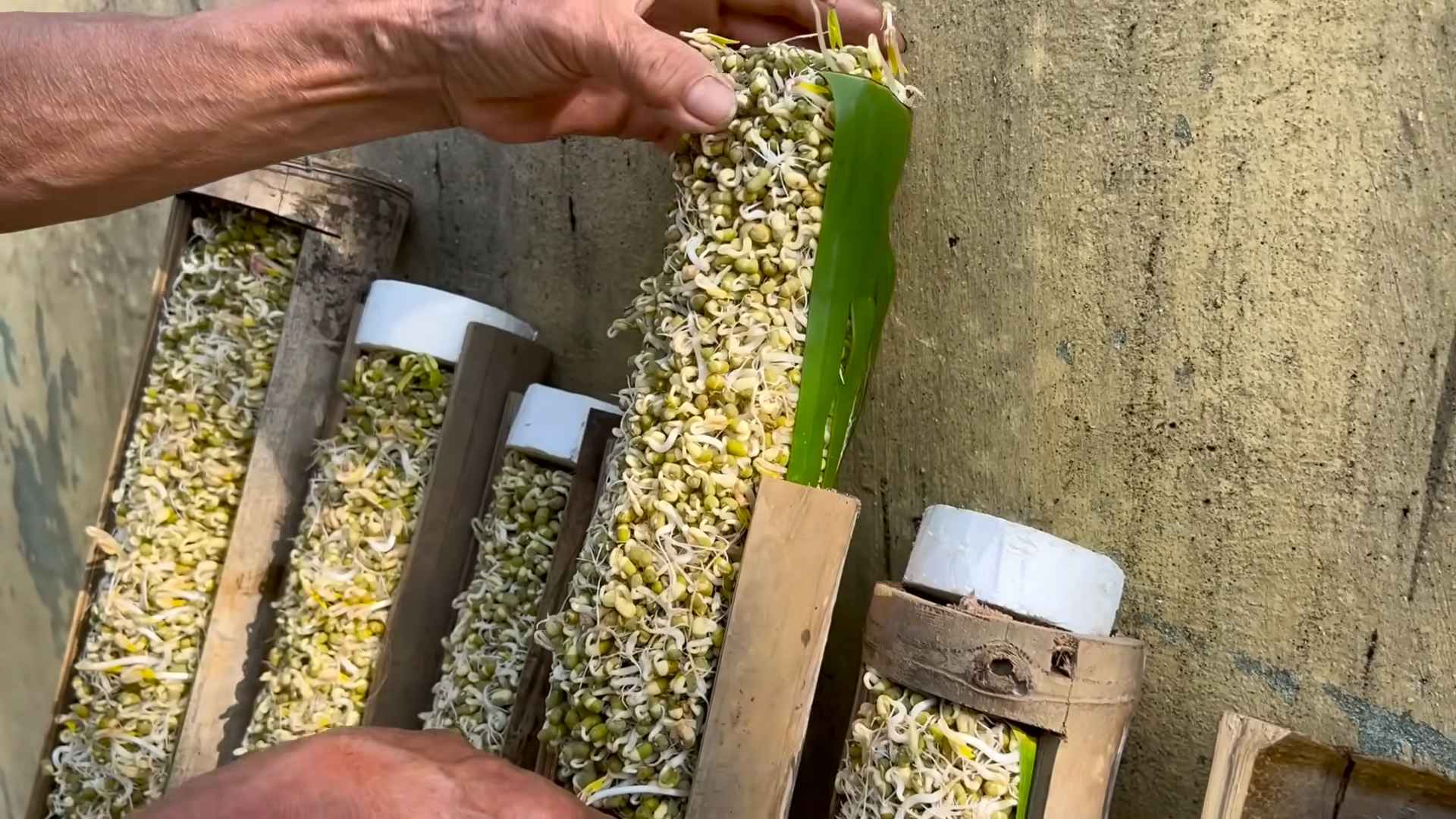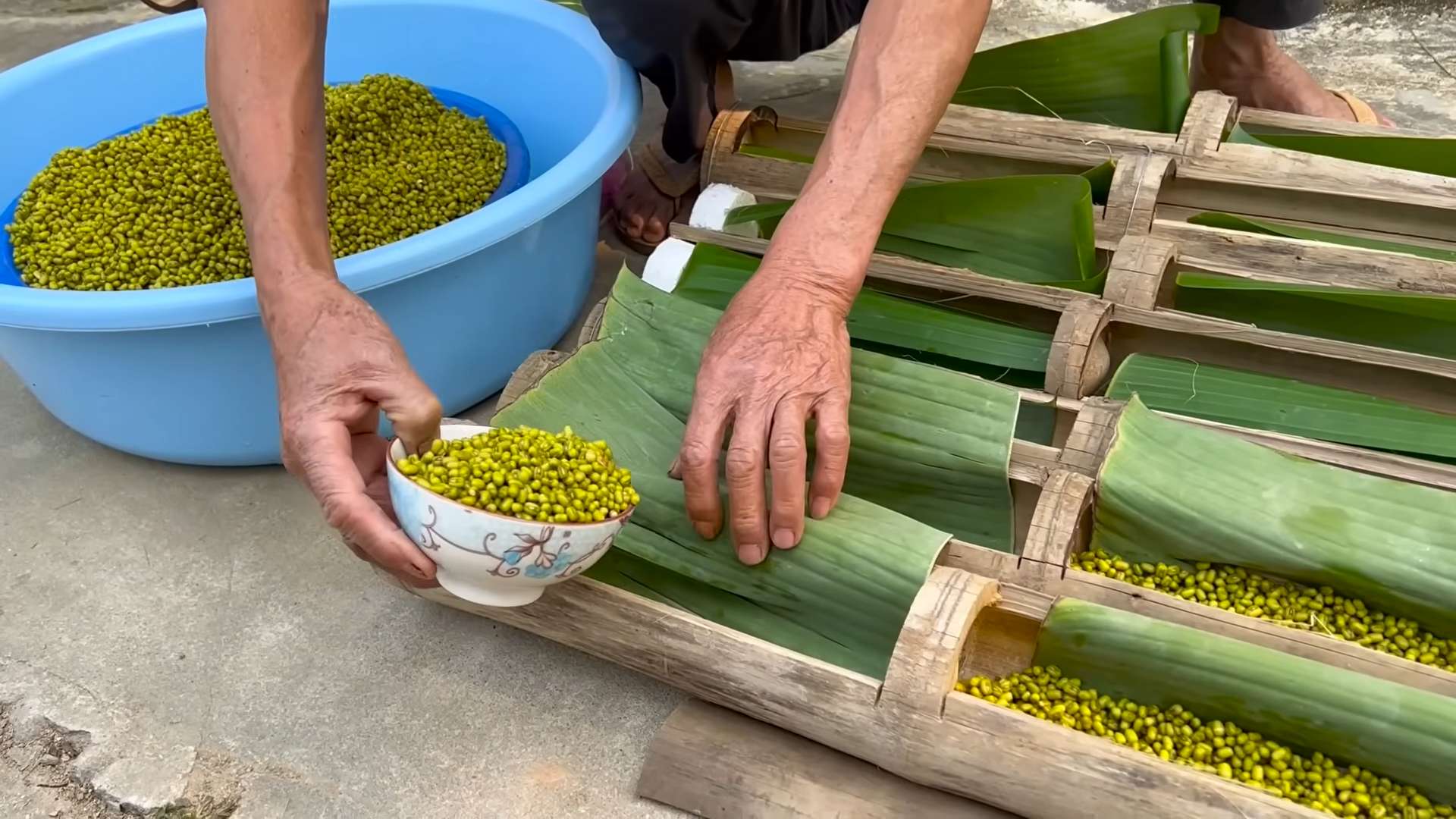Grow Bean Sprouts Easily, even if you think you have a black thumb! Have you ever craved a fresh, crunchy addition to your salad or stir-fry, but dreaded the thought of a trip to the grocery store? What if I told you that you could have a constant supply of delicious, homegrown bean sprouts right in your kitchen, with minimal effort and maximum freshness? This DIY guide will unlock the secrets to cultivating your own vibrant sprouts, transforming you from a sprout novice to a sprouting pro in no time!
Sprouting, in fact, isn’t a new-fangled trend. It’s a practice with roots stretching back centuries, particularly in Asian cultures where sprouts have long been valued for their nutritional power and culinary versatility. Think of the vibrant flavors of Vietnamese pho or the satisfying crunch in a Korean bibimbap 鈥?bean sprouts are often the unsung heroes!
But beyond their deliciousness, why should you bother to grow bean sprouts easily at home? Well, for starters, store-bought sprouts can sometimes be a bit鈥ifeless. Plus, there’s the added benefit of knowing exactly where your food comes from and avoiding any unnecessary preservatives. More importantly, sprouting dramatically increases the nutritional value of the beans, making them a powerhouse of vitamins and enzymes. So, ditch the store-bought bags and get ready to embark on a fun, rewarding, and incredibly easy sprouting adventure! I promise, you’ll be amazed at how simple it is to grow your own fresh, healthy bean sprouts.

Grow Bean Sprouts Easily at Home: A Simple DIY Guide
Hey there, fellow sprout enthusiasts! I’m so excited to share my super easy method for growing bean sprouts right in your kitchen. Forget buying them at the store 鈥?this way is fresher, cheaper, and honestly, way more satisfying. Plus, it’s a fantastic way to add a healthy crunch to your salads, stir-fries, and sandwiches. Let’s get sprouting!
What You’ll Need
Before we dive in, let’s gather our supplies. The beauty of this project is that you probably already have most of these things lying around:
* **Bean Seeds:** Mung beans are the classic choice, but you can also use adzuki beans, lentils, or even chickpeas. Just make sure they’re specifically sold for sprouting, as regular dried beans might not germinate well. About 1/4 to 1/2 cup of beans is a good starting point.
* **A Wide-Mouth Jar:** A quart-sized mason jar works perfectly.
* **Sprouting Lid or Cheesecloth and Rubber Band:** A sprouting lid is ideal because it allows for easy draining and ventilation. If you don’t have one, a piece of cheesecloth secured with a rubber band will do the trick.
* **Water:** Clean, filtered water is best.
* **A Bowl or Plate:** To prop the jar at an angle for drainage.
* **A Dark Place:** A cupboard or drawer works great.
* **Optional: Hydrogen Peroxide (3%):** This can help prevent mold growth, especially in humid environments.
Getting Started: Prepping Your Beans
This is a crucial step, so don’t skip it! Soaking the beans wakes them up and gets them ready to sprout.
1. **Rinse the Beans:** Place your beans in a strainer and rinse them thoroughly under cool water. This removes any dust or debris.
2. **Soak the Beans:** Transfer the rinsed beans to your jar. Add enough cool water to cover them completely, plus a couple of inches extra, as they’ll expand as they soak.
3. **Soak Time:** Let the beans soak for 8-12 hours, or even overnight. I usually soak mine before bed and they’re ready to go in the morning.
The Sprouting Process: Day by Day
Now for the fun part! This is where the magic happens.
1. **Drain and Rinse:** After soaking, drain the water from the jar using your sprouting lid or cheesecloth. Rinse the beans thoroughly with cool water. This is super important to prevent mold and keep your sprouts happy.
2. **Invert and Drain:** Place the jar upside down in a bowl or on a plate at an angle. This allows excess water to drain out while still allowing air to circulate.
3. **Darkness is Key:** Place the jar in a dark, cool place, like a cupboard or drawer. Darkness encourages the sprouts to grow long and white.
4. **Rinse and Drain (Twice a Day):** This is the most important part of the entire process! Rinse and drain your sprouts at least twice a day 鈥?morning and evening. This keeps them hydrated and prevents mold growth. I sometimes do it three times a day if I remember.
5. **Repeat:** Continue rinsing and draining twice a day for the next 3-5 days, or until your sprouts reach your desired length. You’ll see tiny tails emerge from the beans, and they’ll gradually grow longer each day.
Troubleshooting: Common Issues and Solutions
Sometimes things don’t go exactly as planned. Here are a few common problems and how to fix them:
* **Mold Growth:** If you see fuzzy, white or gray mold, it’s likely that your sprouts aren’t getting enough ventilation or are staying too wet. Make sure you’re rinsing and draining them thoroughly. You can also add a teaspoon of 3% hydrogen peroxide to the rinse water to help kill mold spores. If the mold is extensive, it’s best to discard the batch and start over.
* **Slow Growth:** If your sprouts are growing slowly, it could be due to temperature. Sprouts prefer a cool environment (around 60-70掳F). If your kitchen is too warm, try moving them to a cooler location. Also, make sure they’re getting enough darkness.
* **Unpleasant Smell:** A foul smell is a sign of bacterial growth. This usually happens if the sprouts aren’t being rinsed and drained properly. Discard the batch and start over, being extra careful to rinse and drain thoroughly.
Harvesting and Storing Your Sprouts
Once your sprouts are the length you like, it’s time to harvest!
1. **Final Rinse:** Give your sprouts one last thorough rinse.
2. **Remove Hulls (Optional):** Some people prefer to remove the hulls (the outer skins of the beans). You can do this by placing the sprouts in a bowl of water and gently agitating them. The hulls will float to the top and can be skimmed off. This is a bit time-consuming, so I usually skip it.
3. **Dry Thoroughly:** This is important for storage. Spread the sprouts out on a clean kitchen towel or paper towels and let them air dry for a few hours. You can also use a salad spinner to remove excess water.
4. **Store in the Refrigerator:** Place the dried sprouts in a clean container lined with paper towels. Store them in the refrigerator for up to a week. The paper towels will help absorb excess moisture and keep them fresh.
Tips and Tricks for Sprout Success
Here are a few extra tips to help you become a sprout-growing pro:
* Use Good Quality Beans: As I mentioned earlier, make sure you’re using beans specifically sold for sprouting. These are more likely to germinate well and are less likely to be treated with chemicals.
* Don’t Overcrowd the Jar: Start with a small amount of beans. Overcrowding can lead to poor ventilation and increased risk of mold growth.
* Experiment with Different Beans: Once you’ve mastered mung bean sprouts, try other varieties like adzuki beans, lentils, or chickpeas. Each has its own unique flavor and texture.
* Keep it Clean: Cleanliness is key to preventing mold and bacterial growth. Make sure your jar, sprouting lid, and any other equipment you use are thoroughly cleaned before each batch.
* Taste Test: Before adding your sprouts to a dish, give them a taste. They should taste fresh and slightly nutty. If they taste bitter or off, discard them.
* Sunlight (Briefly): Exposing your sprouts to indirect sunlight for a few hours before harvesting can help them develop chlorophyll and turn a light green color. This also increases their nutritional value. Just don’t leave them in direct sunlight, as this can overheat them.
Using Your Homegrown Sprouts
Now that you have a bounty of fresh, homegrown sprouts, it’s time to enjoy them! Here are a few of my favorite ways to use them:
* Salads: Add a handful of sprouts to your salads for a crunchy and nutritious boost.
* Sandwiches and Wraps: Sprouts add a great texture and flavor to sandwiches and wraps.
* Stir-Fries: Toss sprouts into your stir-fries during the last minute of cooking to retain their crunch.
* Soups: Sprinkle sprouts on top of soups for a fresh and healthy garnish.
* Spring Rolls: Sprouts are a classic ingredient in spring rolls.
* Smoothies: Add a small handful of sprouts to your smoothies for an extra dose of vitamins and minerals.
Why Grow Your Own Sprouts?
Besides being incredibly easy and cost-effective, growing your own sprouts has several other benefits:
* Freshness: Homegrown sprouts are much fresher than store-bought ones, which can often be several days old.
* Nutrition: Sprouts are packed with vitamins, minerals, and enzymes. They’re a great source of protein, fiber, and antioxidants.
* Control: When you grow your own sprouts, you have complete control over the growing process. You know exactly what’s going into them and can be sure they’re free of pesticides and other harmful chemicals.
* Sustainability: Growing your own sprouts is a sustainable way to add fresh, healthy food to your diet. It requires very little energy and resources.
* Fun: It’s just plain fun to watch your sprouts grow! It’s a great project for kids and adults alike.
So there you have it! My simple and easy guide to growing bean sprouts at home. I hope you give it a try and enjoy the delicious and nutritious results. Happy sprouting!

Conclusion
So, there you have it! Growing your own bean sprouts at home is not only incredibly easy, but it’s also a fantastic way to add a burst of freshness and nutrition to your meals. Forget those limp, flavorless sprouts from the grocery store 鈥?with this simple DIY trick, you can cultivate crisp, vibrant bean sprouts bursting with flavor, all from the comfort of your own kitchen.
Why is this a must-try? Because it’s economical, sustainable, and undeniably delicious. You’re in complete control of the process, ensuring that your sprouts are free from harmful chemicals and grown in a hygienic environment. Plus, the satisfaction of harvesting your own food is simply unmatched. Think about it: a handful of humble beans transforming into a crunchy, nutritious addition to your salads, sandwiches, stir-fries, and more.
But the fun doesn’t stop there! Feel free to experiment with different types of beans. Mung beans are the classic choice, but you can also try adzuki beans, lentils, or even chickpeas for a unique flavor profile. Consider adding a touch of spice to your rinsing water 鈥?a pinch of chili flakes can impart a subtle heat to your sprouts. Or, if you’re feeling adventurous, try sprouting a mix of different beans for a colorful and flavorful medley. You can also experiment with different sprouting containers. While a mason jar works perfectly, you could also use a sprouting bag or a multi-tiered sprouting system for larger batches.
The key to successful grow bean sprouts easily lies in consistency. Remember to rinse your sprouts regularly, keep them in a dark, well-ventilated area, and be patient. Within a few days, you’ll be rewarded with a bountiful harvest of fresh, delicious sprouts.
We’re confident that once you try this DIY trick, you’ll be hooked. It’s a simple, rewarding, and incredibly satisfying way to add a healthy and flavorful element to your diet. So, ditch the store-bought sprouts and embrace the joy of growing your own.
Now, it’s your turn! We encourage you to give this method a try and share your experience with us. Let us know what types of beans you used, what variations you experimented with, and how your sprouts turned out. Share your photos and tips in the comments below 鈥?we can’t wait to hear from you! Happy sprouting!
Frequently Asked Questions (FAQs)
What types of beans work best for sprouting?
Mung beans are the most commonly used and generally considered the easiest to sprout. However, you can also successfully sprout adzuki beans, lentils, chickpeas, and even some types of peas. Just be sure to use beans specifically intended for sprouting or cooking, not ornamental beans, as some ornamental varieties can be toxic. Avoid using split beans, as they won’t sprout properly.
How long does it take to grow bean sprouts?
Typically, it takes between 3 to 5 days to grow bean sprouts to a usable size. The exact time will depend on the type of bean, the temperature, and the humidity. Warmer temperatures generally speed up the sprouting process, while cooler temperatures may slow it down. Keep an eye on your sprouts and harvest them when they reach your desired length and crispness.
What kind of container should I use for sprouting?
A wide-mouth mason jar is a popular and effective choice for sprouting. You can cover the mouth of the jar with cheesecloth or a sprouting lid. Other options include sprouting bags, multi-tiered sprouting systems, or even a simple colander lined with cheesecloth. The key is to choose a container that allows for good drainage and ventilation.
How often should I rinse the bean sprouts?
Rinsing your bean sprouts is crucial to prevent mold and bacteria growth. You should rinse them at least twice a day, preferably three times, with cool, clean water. Be sure to drain the water thoroughly after each rinsing.
Why are my bean sprouts not growing?
There could be several reasons why your bean sprouts aren’t growing. First, make sure your beans are viable and intended for sprouting. Old or damaged beans may not sprout. Second, ensure that you’re rinsing the sprouts regularly and providing adequate drainage. Third, check the temperature 鈥?sprouts prefer a relatively warm environment (around 70-75掳F). Finally, make sure the sprouts are kept in a dark place, as light can inhibit their growth.
Why are my bean sprouts turning brown?
Brown bean sprouts are usually a sign of either insufficient rinsing or exposure to too much light. Make sure you’re rinsing your sprouts at least twice a day and keeping them in a dark, well-ventilated area. If the browning is only slight, you can still use the sprouts, but if they are significantly discolored or have a slimy texture, it’s best to discard them.
How do I store bean sprouts?
Once your bean sprouts have reached your desired size, you can store them in the refrigerator for up to a week. To store them, rinse them thoroughly and drain them well. Then, place them in a clean container lined with a paper towel. The paper towel will help absorb excess moisture and keep the sprouts fresh.
Are there any health benefits to eating bean sprouts?
Yes! Bean sprouts are a nutritional powerhouse. They are low in calories and fat but high in vitamins, minerals, and fiber. They are a good source of vitamin C, vitamin K, folate, and manganese. They also contain antioxidants and enzymes that can promote overall health.
Can I eat bean sprouts raw?
Yes, you can eat bean sprouts raw, but it’s important to rinse them thoroughly before consuming them to remove any potential bacteria. Some people prefer to lightly cook their bean sprouts to further reduce the risk of foodborne illness.
What are some ways to use bean sprouts in my cooking?
Bean sprouts are incredibly versatile and can be used in a variety of dishes. They are a popular addition to salads, sandwiches, stir-fries, spring rolls, and soups. They can also be used as a garnish or added to smoothies for a nutritional boost. Get creative and experiment with different ways to incorporate bean sprouts into your meals.
Is it safe to grow bean sprouts at home?
Growing bean sprouts at home is generally safe, but it’s important to follow proper hygiene practices to minimize the risk of foodborne illness. Always use clean water and containers, rinse the sprouts regularly, and store them properly. If you have any concerns about food safety, it’s always best to err on the side of caution and cook the sprouts before consuming them.





Leave a Comment